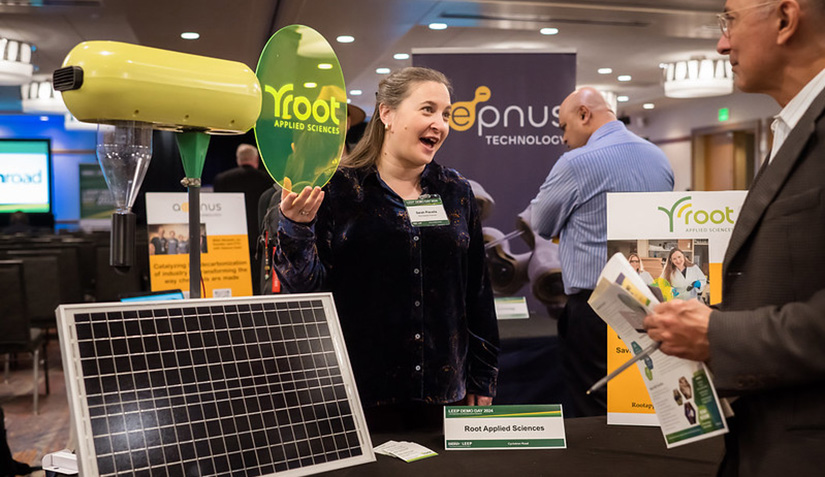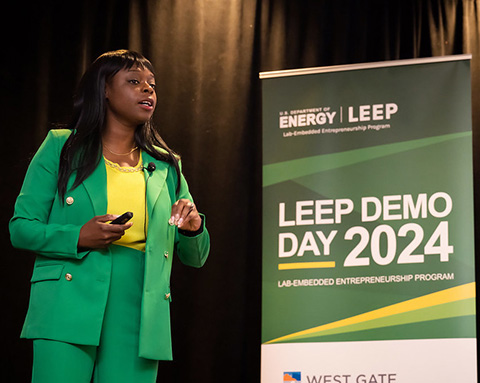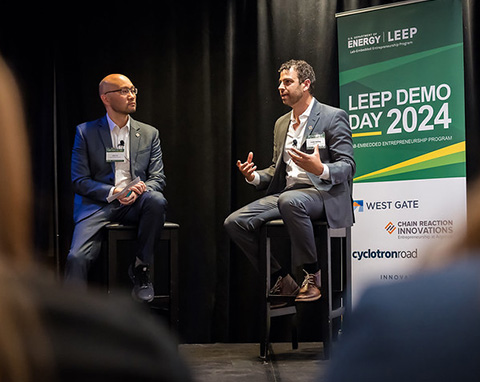
While it may seem like all the great tech ideas are in slick startups on the coasts, “eureka” moments are happening in kitchens, cars, and classrooms across the United States.
To find these untapped potential resources, the U.S. Department of Energy (DOE) is investing in creative clean tech problem solvers through the Lab-Embedded Entrepreneurship Program (LEEP), a two-year program for promising entrepreneurs developing innovative energy technologies.
On May 1, at LEEP Demo Day in Denver, Colorado, the newest group of LEEP graduates took to the stage to share how this career-changing opportunity helped them transform their inspiration into a market-ready product.

“At the Department of Energy, we are committed to doing all we can to accelerate the clean energy transition,” said Jeff Marootian, Principal Assistant Secretary for the Department of Energy’s Office of Energy Efficiency and Renewable Energy. “We are proud to support the national laboratories and entrepreneurs who are leading this effort, and it is critical that we work together to scale, commercialize and bring these technologies out into the world to make a difference.”
LEEP innovators tackle a variety of climate issues, including emissions, single-use plastics, overflowing landfills, and agricultural and industrial waste. Some have ideas to change existing practices to make them more efficient, cleaner and less wasteful, while others propose entirely new alternatives to the status quo.
Four innovators are in the first cohort of West Gate, a LEEP node at the National Renewable Energy Laboratory (NREL). One innovator, Mikhail Konev, is enabling circularity in fibers by using oxygen to break down plastics into their base components. His colleague, Stefan Streckfus, is converting disused oil and gas wells into gravity energy storage systems. Andrew Gabor is pioneering ultraviolet fluorescence technology to enhance defect imaging in solar panels. Grant Gunnison is revolutionizing residential electrification by providing homeowners with an app-driven platform that drastically reduces the time and cost of estimated projects.

But having a great idea is easy; proving commercial viability requires cycles of prototyping, testing, planning, and improving — a process that can take years for aspiring entrepreneurs who struggle to find enough time and funding to devote to their ideas.
What makes LEEP Demo Day so exciting is that, thanks to LEEP’s structure, these technical ideas can blossom into tangible products in a much shorter time.
“LEEP fills an existing gap for innovators at the most critical time for hard technology ideas: early stage,” said Paul Syers, the Department of Energy’s LEEP program manager. “We bring together the best ideas from around the country and connect them to our national laboratories.”

LEEP offers innovators a living wage, access to world-class facilities, and a network of experts at national labs including Chain Reaction Innovations at Argonne National Laboratory, Innovation Crossroads at Oak Ridge National Laboratory, Cyclotron Road at Lawrence Berkeley National Laboratory, and West Gate at NREL. This financial stability and the freedom to focus on their ideas allows selected innovators to accelerate to market in just two years.
The secret to this rapid success is blending the worlds of science and business: Technical development activities are complemented by business development coaching, says Shelly Curtiss, NREL’s West Gate program director, ensuring a customized LEEP experience that provides the right balance of each and leverages an external advisory network.
“We leverage local resources as much as possible,” Curtis says, “NREL has a strong investment advisory committee that Westgate turns to for advice on raising capital and fundraising, and of course our incredible lab researchers provide the kind of technical expertise these innovators might never get anywhere else.”
The LEEP Demo Day was the culmination of two years of work, with 20 entrepreneurs from all four nodes presenting their market-ready solutions to an audience of investors, decision-makers and change-makers from across the country. The event attracted over 150 participants, showcasing the momentum and impact of LEEP.
“In less than 10 years since LEEP began, our innovators have collectively secured more than $2.6 billion in additional funding, the vast majority of which, more than 50 percent, has come from the private sector,” Sayers says. “LEEP alumni are one of the program’s best resources – who better to understand the perspective of building a cleantech company from the ground up?”

LEEP’s passion for helping fellow innovators overcome obstacles was a shining light in the eyes of LEEP Demo Day keynote speaker and program alumnus Justin Whiteley, whose plant-based Meati products are now sold nationwide.
“I love helping people think about, ‘How do we scale this idea?’ Because we want to have real impact, we want to do good for society, we want to do good for the planet. And the only way to do that is at scale. So the question is, ‘How do we get from here to there?’ Because sometimes it’s so hard to figure that out.”
“LEEP has been so helpful in helping us out, so we want to give back to them in any way we can,” Whiteley said. [Meati] It sets you up for success. The value comes from helping the hardest companies to build.”
The growing impact of these cleantech startups ranges from local to national economies: collectively, LEEP innovators have created more than 2,300 jobs, launched 155 new businesses, and achieved a 97% startup success rate.
Click here for details NREL’s West Gate program.

